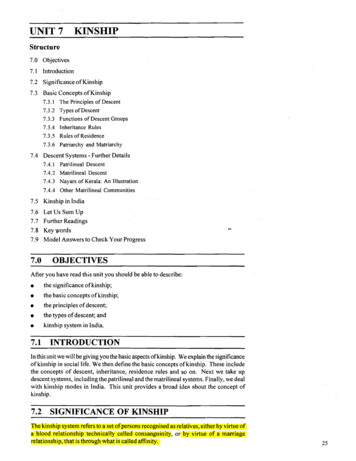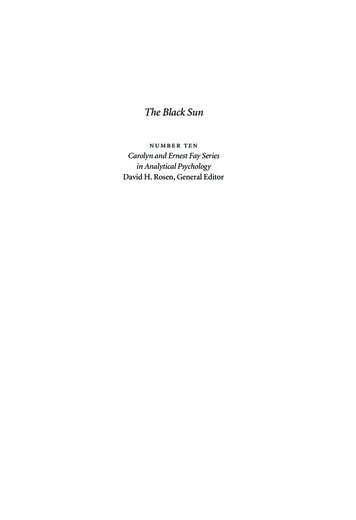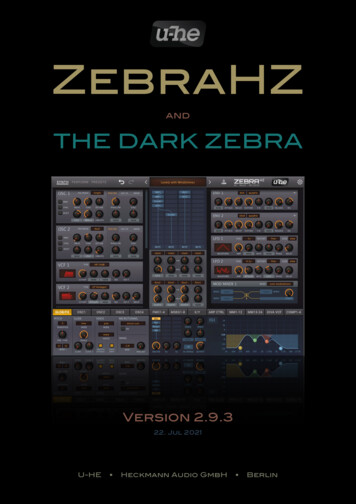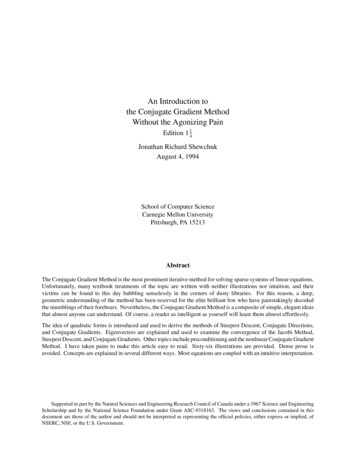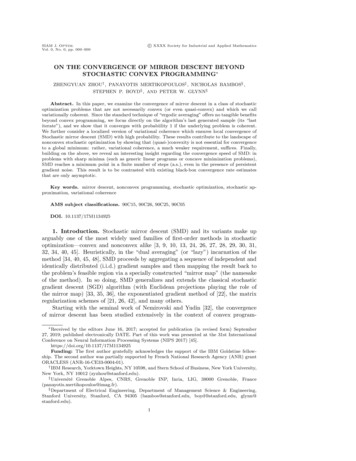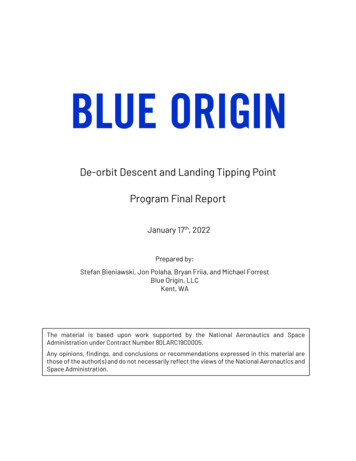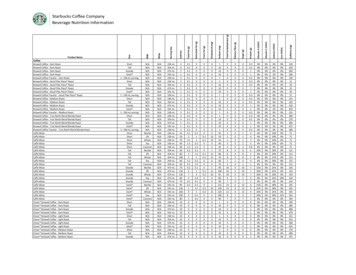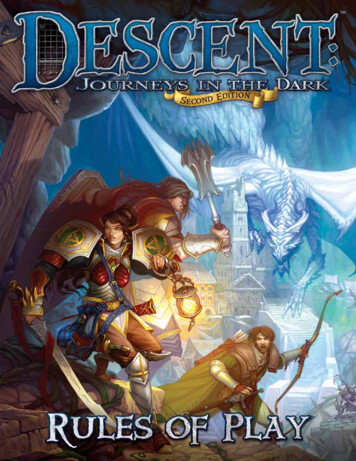
Transcription
IntroductionThey crept down the stone stairs as silently as possible, not daring to announcetheir presence to whatever foul minions lurked in the shadows. The faint glow fromLeoric’s enchanted stone did little to illuminate the gathering dark. Jain slowlynotched an arrow, gracefully pulling her bowstring taut as the small silhouette ofTomble spun his knives behind her. “He is here somewhere,” Avric whispered, “beprepared.”“Greetings, brave heroes,” a boisterous voice suddenly announced from thedarkness. “You have come so far! ‘Tis a shame your journey ends here.” As thevoice faded to the sound of distant cackling, dozens of monstrous shapes emergedto surround the heroes. The chamber soon rang with the sounds of battle.Game OverviewDescent: Journeys in the Dark Second Edition is a game for two to five playersin which one player takes on the role of the overlord, while all other playerstake on the roles of heroes. During each game, the heroes undertake questsby venturing into dangerous caves, ancient ruins, dark dungeons, andcursed forests. Along the way, they will battle monsters, earn riches,and attempt to stop the overlord from carrying out his evil plot.Object of the GameBefore each game, the players select one of the quests listed in the Quest Guide.Each quest presents the players with specific objectives they need to complete to win thegame. The heroes will either win or lose as a team, while the overlord wins or loses individually.The game can also be played as a campaign with multiple quests linked together to form anepic story. During a campaign, players earn upgrades and increase in power over the courseof several play sessions. The majority of this rulebook is written assuming that players areplaying a single scenario (and not the campaign). Campaign rules are explained later in thisrulebook (see “Campaign Rules” on page 19).Component ListThis game includes the following: This Rulebook 1 Quest Guide 8 Hero Figures 31 Monster Figures, consisting of:––5 Zombies; 4 tan and 1 red––5 Goblin Archers; 4 tan and 1 red––5 Cave Spiders; 4 tan and 1 red––4 Flesh Moulders; 3 tan and 1 red––4 Barghests; 3 tan and 1 red––2 Ettins; 1 tan and 1 red––2 Elementals; 1 tan and 1 red––2 Merriods; 1 tan and 1 red––2 Shadow Dragons; 1 tan and 1 red 9 Custom Six–sided Dice, consisting of:2––1 Blue Attack Die––2 Red Power Dice––2 Yellow Power Dice––1 Brown Defense Die––2 Gray Defense Dice––48 Map Tiles––1 Black Defense Die––45 Damage Tokens 7 Plastic Stands––35 Fatigue Tokens 8 Hero Sheets––7 Doors 1 Pad of Campaign Sheets––16 Hero Tokens 152 Small Cards, consisting of:––9 Search Tokens 205 Tokens, consisting of:––84 Class Cards––6 Lieutenant Tokens––20 Act I Shop Item Cards––10 Objective Tokens––14 Act II Shop Item Cards––8 Villager Tokens––16 Condition Cards––20 Condition Tokens––12 Search Cards––1 Reanimate Familiar Token––6 Relic Cards 84 Bridge-sized Cards, consisting of:––40 Overlord Cards––18 Monster Cards––12 Lieutenant Cards––10 Travel Event Cards––4 Activation Cards
Component OverviewThis section describes the various components in detail.Quest GuideThe Quest Guide lists all of the quests in the game,including setup, special rules, and the objectivesfor each quest. Players will refer to this guide whenchoosing and setting up each quest.Plastic FiguresHeroes and monsters are representedon the game board by plastic figures.Hero figures are gray, while eachmonster is either tan or red. Tanmonsters represent minion monstersand red monsters represent mastermonsters, more powerful versions ofthe minion monsters.Relic CardsRelic cards represent unique and powerful items inthe campaign. These items can be acquired by eitherthe hero players or the overlord player.Overlord CardsThe overlord player uses these cards toperform various abilities, such as benefitingmonsters or springing a trap on the heroes.There are both basic Overlord cards, whichthe overlord player begins the game with, aswell as upgrade cards, which he can purchasewith experience points when playing the campaign.Monster CardsCustom DiceThese dice are used to resolve attacks, tests, and othersimilar game elements which rely on a randomlydetermined outcome.These cards list all the information for thedifferent monsters in the game. The faceof the card shows the monster’s importantcharacteristics and abilities, while the backof the card lists detailed rules for all themonster’s abilities as well as the number offigures used based on the number of heroesin the game. Each monster has both an Act Icard and an Act II card.Hero SheetsLieutenant CardsEach Hero sheet contains all the information theplayer needs to play a particular hero.Campaign SheetsThese sheets are used during campaign play. Players usethese sheets to track important information between gamesessions within a campaign.Class CardsThese cards are divided into eight separate decksthat represent the eight different hero classes in thegame. Each deck contains all the skills and startingequipment belonging to that class.Shop Item CardsThese cards represent the different items heroes canfind or purchase in the game. They are divided intoAct I items and Act II items.Condition CardsThe rules for the different ongoing effects in thegame are listed on these cards. When a figure isinflicted with a condition, players use these cards toreference the effects of that condition.Search CardsThese cards represent useful items that heroes maydiscover during a quest. Search cards are drawnwhen a hero performs a search action. Duringcampaign play, heroes also receive the amount ofgold listed on the card.Similar to the Monster cards, these cards listthe information of the overlord’s powerfulallies known as lieutenants. Each lieutenanthas both an Act I card and an Act II card.Travel Event CardsDuring campaign play, these cards determineif there is an event for the heroes while theytravel.Activation CardsThese cards list a summary of the hero andoverlord turns, and they mark which heroeshave completed their turn. There are fourdifferent colors of these cards and each colorcorresponds to a color of hero token.Map TilesThese puzzle-cut tiles representdifferent locations heroes exploreduring the game. Each quest has aunique layout that uses differentcombinations of map tiles. All maptiles are double-sided, with one sideshowing an indoor location andthe other side showing an outdoorenvironment.3
Damage and FatigueTokensThese tokens track the amount of damageor fatigue heroes suffer during a quest. Thedamage tokens are also used to track damagemonsters and lieutenants have suffered.Doors and PlasticStandsThese doors are placed on the map insome quests. There are both normaldoors and locked doors. Before playingthe game, insert each door token intoone plastic stand.Before PlayBefore playing Descent: Journeys in the Dark Second Edition, carefullypunch out all tokens and map tiles from the cardboard frames. Then,insert the door tokens into the plastic stands.Some of the larger monster figures require a little basic assembly. Playersshould simply insert the appropriate monster figure pieces into thecorresponding monster figure. If players wish, they may use a smallamount of hobby glue when assembling the figures.SetupThese tokens are useful for keeping track of importantinformation as instructed by the rules or card effects.Setting up a game of Descent: Journeys in the Dark Second Editioninvolves different steps for the overlord player and the hero players.Certain quests may also have quest specific setup instructions listed in theQuest Guide. The following instructions are written assuming playersare playing the basic game. The basic game is a single quest played overthe course of a single play session. Players may also play quests as part of acampaign or using the Epic Play variant (see “Campaign Rules” and “EpicPlay” on page 19).Search TokensGeneral SetupHero TokensThese tokens mark the spaces in a quest where heroes cansearch for items, potions, and quest specific articles. Oneof these tokens has a unique back and is only used duringspecific quests.Lieutenant TokensThese tokens represent lieutenants on the map. Theart on the token matches the art on the correspondingLieutenant card.Objective TokensMany quests in the game have different objectives forboth the overlord player and the hero players. Thesetokens mark the locations of objectives on the map.Objective tokens have a unique colored back for use inspecific quests.Villager TokensThese tokens represent the different characters thatheroes can encounter in quests, such as villagers,guards, or other characters important to a particularquest. The Quest Guide lists any special rules regardingthese characters.Before playing, set up the game as follows:1. Choose Quest: Descent: Journeys in the Dark Second Editionincludes 16 unique quests (along with 4 campaign-specific quests)with specific setup instructions and objectives for both the heroes andthe overlord. When choosing which quest to play, refer to the QuestGuide. For a player’s first game, we suggest choosing “First Blood,” anintroductory quest.2. Assemble Map: Players refer to the chosen quest’s “Encounter 1”diagram in the Quest Guide to assemble the map. Place any doorsused in the quest as indicated in the Quest Guide.3. Choose Player Roles: Players decide who will take on the role of theoverlord. It is recommended that the most experienced player take onthis role. All other players take on the roles of the heroes. If all playersdo not agree, then this decision is made randomly (such as by rollinga die).4. Prepare Tokens: Sort all damage, fatigue, hero, and condition tokensinto piles by type. Place each pile of tokens within easy reach of allplayers.5. Assemble Search Deck and Condition Cards: Take all the Searchcards and shuffle them together. Place the Search deck facedownwithin easy reach of the hero players. Place the Condition cards inseparate piles based on their type, within easy reach of all players.Condition TokensThese tokens are used to signify when monsters areaffected by ongoing effects. These tokens correspond tovarious Condition cards.Familiar TokenThis token is used to represent a familiar controlled by ahero player. In this case, the Necromancer's Reanimate.Hero ArchetypesEvery hero has an archetype that is printed on his Hero sheet.This archetype defines what classes are available to that hero.These archetypes are:Warrior4HealerMageScout
Hero SetupOverlord Setup1. Take Activation Cards and Hero Tokens: Each hero player choosesone Activation card and takes the hero tokens of the correspondingcolor.1. Choose Monsters: The Quest Guide lists the monster group optionsavailable to the overlord for the chosen quest. He takes the Act IMonster cards and figures for the chosen monster groups and placesthem in front of him. See “Monsters” on page 2 of the Quest Guidefor more rules on choosing monsters.After completing General Setup, the hero players continue setupas follows. The overlord player then performs Overlord Setup (see“Overlord Setup”).2. Choose Heroes: All hero players must agree on which player controlswhich hero. Each hero player chooses one Hero sheet and takes thecorresponding hero figure. In a two-player game, the lone hero playercontrols two different heroes (see “Two-player Game” on page 18).3. Choose Classes: Each hero player chooses one Class deck matchinghis chosen hero’s archetype icon (printed on his Hero sheet; see“Hero Archetypes” on page 4). Each archetype has differentclasses available; there are two such classes available for each archetypein the game, each one defining which skills are available to a hero ofthat class. Any Class deck belonging to a class not chosen is returnedto the game box.When a player chooses a class for his hero, he takes the deck of cardsfor that class (see “Class Card Anatomy” on page 8). This Classdeck includes the starting equipment for the hero, as well as all ofthe skills associated with that class. A player may not select a heroclass that does not match the archetype icon shown on the hero’sHero sheet. Furthermore, a player may not select a class that has beenchosen by another player.4. Choose Skills: Every hero begins the game with the basic skill (theskill card with no experience icon) and starting equipment from hisClass deck.The overlord player performs the following steps after hero playersperform Hero Setup (see “Hero Setup”).Many quests also feature a specific lieutenant that the overlord usesduring the quest. The overlord player takes the appropriate Act ILieutenant card and token and places them in front of him.2. Perform Quest Setup: The overlord refers to the “Setup” section ofthe chosen quest and follows the instructions listed. This includesplacing monster figures, objective tokens, search tokens, and villagertokens as indicated on the quest map.3. Create Overlord Deck: The overlord player shuffles the 15 basicOverlord cards to create his Overlord deck.When playing the basic game, all other Overlord cards are returnedto the game box. These cards are only used if playing a campaign or ifusing the Epic Play variant (see “Campaign Rules” and “Epic Play” onpage 19).4. Draw Overlord Cards: The overlord player draws a number ofOverlord cards equal to the number of heroes into his hand (see“Overlord Cards” on page 16).After players have finished Hero Setup and Overlord Setup, they areready to begin playing the game.When playing the basic game, all other skills are returned to the gamebox. These skills are only used if playing a campaign or using the EpicPlay variant (see “Campaign Rules” and “Epic Play” on page 19).Map Tile Breakdown5. Place Heroes: Each player places his hero figure on the map in thearea indicated by the quest rules for hero setup. This is typically on anentrance tile.31421.Map Tile: A map tile is a single large token used withother map tiles to build the quest map.2.Space: Each map tile consists of several square spaces(such as the one marked in red). Spaces may have specialrules depending on their contents.3.Tile Code: All map tiles are labeled with a unique tilecode for easy identification. Each tile code consists ofone number and one letter.4.Edge: Each map tile features a puzzle-cut edge used toconnect other tiles. The black borders of a tile representimpassable walls that cannot normally be movedthrough (see “Moving Off the Map” on page 9).5
Setup Diagram (Four-player Game)456972383211034421. Map: The map is set up in the center of the play area with thehero and monster figures, search tokens, and any objectivetokens placed in the appropriate spaces described in the QuestGuide.2. Hero Sheets: Hero players place their Hero sheets faceup infront of them.3. Class Cards: Hero players place their Class cards faceup in frontof them, next to their Hero sheets.4. Activation Cards and Hero Tokens: Hero players place theirActivation cards with the corresponding hero tokens in front ofthem, for easy reference.5. Overlord Cards: The overlord player shuffles his deck ofOverlord cards and places it facedown in front of him.66. Monster Cards: The overlord player takes all Monster cardsneeded for the quest, specified in the Quest Guide, and placesthem in front of him.7. Damage and Fatigue Token Supplies: Place all damage andfatigue tokens in separate piles within easy reach of all players.8. Search Cards: Shuffle the deck of Search cards and place itfacedown near the map within easy reach of the hero players.9. Condition Cards and Tokens: Place all Condition cards andtokens within easy reach of all players.10. Dice: Place all of the dice near the center of the play area withineasy reach of all players.
Playing the GameHero Turn SummaryDescent: Journeys in the Dark Second Edition is played over a number ofgame rounds. A round consists of each player taking one turn, beginningwith one of the heroes. Each player completes his entire turn beforeanother player begins his turn. Each round, the hero players decide as agroup the order in which they wish to act. This order may be differenteach round. If they cannot all agree on an order, they proceed clockwise,starting with the player seated to the left of the overlord. After all heroeshave completed their turns, the overlord’s turn begins. After the overlordplayer finishes his turn, the round ends and a new round begins.During each hero turn, the active hero player performs the following stepsin order.Hero Sheet Anatomy3. Perform Actions: During each hero’s turn, he receives two actions.He may perform these actions in any order he chooses, and he is notrequired to perform both actions. Unless noted otherwise, an actionmust be resolved completely before the hero performs his next action.312542.2. Equip Items: If the player wishes to equip different items, he mustdo so during this step. The Equipment section of the rulebook givesfull details about equipping cards and the limits of what a hero canhave equipped (see “Equipment” on page 11). Any excess items areflipped facedown and may not be used until they are equipped.The player may perform any of the actions summarized below, andmay even perform the same action twice. See “Hero Turn in Detail”on page 8 for more details on these actions. Move: The hero moves his hero figure up to a number ofspaces equal to the hero’s Speed. The hero may interrupthis movement with another action and then complete hismovement after the other action is resolved. Attack: The hero attacks a monster.Hero sheet back1.1. Start of Turn: During this step, any effects affecting the active herothat last “until the start of your next turn” end. Also, the hero playermay use any abilities that trigger “at the start of your turn.” Thenthe hero player refreshes his exhausted cards (see “Exhausting andRefreshing Cards” on page 8).Hero Name and Archetype: This area displays thename of the hero and the archetype that hero isassociated with. When choosing a class, the archetypeicon must match the corresponding Class deck in orderfor that class to be chosen.Characteristics: All of the hero’s characteristics areshown here. The listed characteristics are, from topto bottom, Speed, Health, Stamina, and Defense.Speed determines how many movement points a figurereceives when performing a move action. A figure’sHealth is the amount of damage it can suffer beforebeing defeated, while Stamina represents the maximumamount of fatigue it may suffer (see “Damage andHealth” and “Fatigue and Stamina” on page 13). Ahero’s Defense value shows the type of defense dice herolls when attacked.3.Hero Ability: All heroes have a unique ability that isdisplayed here.4.Attributes: Hero attributes are shown in this area. Thelisted attributes are Might , Knowledge ,Willpower , and Awareness . These attributesare often tested at different times to see if the hero isable to perform a particular skill, resist a special monsterattack, or avoid a trap played by the overlord (see“Attribute Tests” on page 15).5.Heroic Feat: This area displays the hero’s heroic feat.When a hero uses his heroic feat, the hero player flipshis Hero sheet over to indicate that the hero has usedhis heroic feat (see “Heroic Feats” on page 15). Use a Skill: The hero uses a skill listed on one of his Class cardsthat requires an action. These actions are denoted with a . Rest: The hero will recover all fatigue at the end of this turn. Search: If the hero is adjacent to or in a space containing asearch token, he may reveal the search token. Stand Up: This is the one and only action that a knocked outhero may perform during his turn. This action allows the heroto recover damage and prepare to be activated as normal nextround. Revive a Hero: The hero restores health to a knocked out heroin an adjacent space. Open or Close a Door: The hero opens or closes one adjacentdoor. Special: Different cards or quests may provide heroes withunique actions to perform. These actions are either clearlystated “as an action” or noted with a .4. Flip Activation Card: After a hero player has finished performing hisactions, that hero player flips his Activation card facedown to indicatethat his turn is over.After the player flips his Activation card, another hero begins his turn.After all heroes’ Activation cards are facedown (showing the overlordturn summary), proceed to the overlord turn (see “Overlord TurnSummary” on page 8).7
Hero Turn in DetailClass Card AnatomyDuring each hero turn, the hero may perform any two actions of hischoice. This section explains detailed rules for actions.312Class card back5Move46Class card front1.Archetype Icon: This icon shows which archetype theclass belongs to. A hero must have a matching archetypeicon on his Hero sheet to choose this class (see “HeroSheet Anatomy” on page 7).2.Class Name: This is the name of the class. All Classcards with a matching name belong to the same Classdeck.3.Skill Name: The skill name is listed at the top of thecard along with the class name.4.Experience Icon: This number shows how manyexperience points it costs to purchase the skill. Heroesbegin play their basic skill cards and starting equipment.These basic cards have no experience icon on them.5.Rules: This area lists the rules for the skill.6.Fatigue Cost: Some skills require the hero to sufferfatigue to use. That amount of fatigue is listed here withthe fatigue icon. Any Class card without a fatigue costmay be used without suffering fatigue.Overlord Turn SummaryDuring each overlord turn, the overlord player performs the followingsteps in order.1. Start of Turn: During this step, any effects affecting the overlord thatlast “until the start of your next turn” end. Then, the overlord playerdraws one Overlord card, and he may play any number of Overlordcards that specifically state they may be played “at the start of yourturn.” Then the overlord player refreshes his exhausted cards (see“Exhausting and Refreshing Cards” on page 8).2. Activate Monsters: The overlord activates each of his monstergroups, one at a time, in any order he chooses. Monsters are groupedtogether by type, and a monster group can contain both minion andmaster monsters (see “Monsters” on page 16).When a hero player performs a move action, he receives a number ofmovement points equal to his hero’s Speed (represented by a on theHero sheet). Moving into an adjacent space costs one movement point(with the exception of entering certain types of terrain; see “Terrain” onpage 18). The player may choose to move fewer spaces than his hero’sSpeed. A hero may also decide to perform two move actions consecutively,in which case the hero receives movement points equal to twice his Speed.Figures cannot move into or through spaces containing figures orobstacles (see “Terrain” on page 18). These spaces are known asblocked spaces. However, figures may move diagonally (includingaround corners and between two blocked spaces) and through friendlyfigures. A hero treats all other heroes as friendly figures, while a monstertreats all other monsters as friendly figures. A figure cannot end itsmovement in the same space as another figure.A hero performing a move action may interrupt his movement to performanother action, such as attacking, and continue the rest of his movementafter resolving the other action. For example, a hero with a Speed of “4”could move two spaces, perform an attack, and then move two morespaces after resolving the attack.Monsters follow the same movement rules as heroes when moving exceptthat monsters cannot suffer fatigue to receive additional movement points(see “Additional Movement” below).Additional movementA hero may suffer fatigue to receive additional movement points duringhis turn. For each fatigue suffered, the hero receives one movement point.If the hero already has fatigue equal to his Stamina, he may not sufferany more fatigue to receive additional movement points (see “Fatigueand Stamina” on page 13). A hero player is not required to perform amove action in order to suffer fatigue to move. During his turn, before orafter resolving an action or during a move action, a hero may suffer fatigueto gain movement points.Exhausting andRefreshing Cards3. End of Round: Each hero flips his Activation card faceup. The nextgame round then begins, starting with a hero player’s turn.Winning the GameEach quest provides specific victory conditions for both the overlordplayer and the hero players. It is important to note that most questsconsist of two parts, called Encounters. Completing Encounter 1 of atwo-part quest does not determine a winner of the entire game. The firstside (heroes or overlord) to satisfy the final encounter’s victory conditionwins the game!8Exhausted CardRefreshed CardSome cards require the player to exhaust them when they areused. When a player exhausts a card, he simply rotates the cardsideways to indicate that he has used its ability. At the startof a player’s turn, he refreshes all of his exhausted cards byreturning them to their upright position. A player cannot usean exhausted card until it is refreshed.
AttackEmpty SpacesSome card effects and abilities refer to empty spaces. An emptyspace is defined as a space that contains no figures and thatblocks neither line of sight nor movement. Unless otherwisenoted, spaces containing tokens are still considered to be emptyfor the purposes of these effects.When a hero player performs an attack action, he may use one of hisequipped weapons to attack a space containing a monster. The hero’sequipped weapon determines which spaces the hero may target for theattack. A weapon with the Melee icon may only target a space adjacent(see “Adjacent Spaces” on page 10) to the attacking hero. A weaponwith the Ranged icon may target any space in line of sight of the attackinghero (see “Combat” on page 12).Moving Off the MapNormally figures cannot move through the walls along the edge of amap tile. Some quests allow figures to move off the map. This usuallyrequires either an entrance or exit tile (see below). To move off the map,the figure must move to one of the edge spaces (marked below in red) onthe entrance or exit tile and then spend one movement point. Except forentrance or exit tiles, figures may not move through the black borders ofthe map tile, as these represent impassable walls. The Quest Guide defineswhich tile is an entrance and which is an exit (if any).MeleeRangedMonster attacks follow the same rules when attacking heroes, except thatmonsters don’t have equipped weapons. Instead, the type of attack (Meleeor Ranged) is listed on its Monster card (along with the dice used in theattack).Combat is performed by resolving the following steps in order. Each stepis detailed in a later section (see “Combat” on page 12):1. Declare Weapon and Target: The attacking player chooses whichof his equipped weapons to use for this attack and declares the targetof the attack (a space containing an enemy figure). The player thencompiles his attack dice into a pool.2. Roll Dice: The attacking player rolls his dice pool while the defendingplayer rolls all necessary defense dice. If an attack affects multiplefigures, each figure rolls its defense dice separately.3. Check Range: When performing a Ranged attack, the attackingplayer must roll enough range to reach the target.Edge spaces of Entrance and Exit tiles4. Spend Surges: After rolling the dice, the attacking player may spendany surge results to trigger special abilities.Movement Example25. Deal Damage: Any damage not canceled by defense dice or othereffects is applied to each affected figure.131.Grisban the Thirsty needs to move past the goblinarchers in this room, but monster figures blockmovement for heroes, so he must find a way aroundthem.2.His Speed is “3,” so he could move straight ahead, butthat move would not get him much closer to the hallwaywhere he wants to go.3.He can move diagonally to cover more ground. Playersshould note that the black edge of the map tile does notblock diagonal movement around corners.Use a SkillWhen a hero performs a use a skill action, he may use a skill that has a listed on his Class card. The player then resolves the skill by following therules listed on the Class card. If the skill allows the hero to perform anattack, the normal rules for performing an attack action apply.Many skills also show a fatigue cost on the card. The hero must suffer thisamount of fatigue in order to perform the listed on the card or triggeran ability that requires the player to “exhaust this card,” or “use thiscard.” See “Fatigue and Stamina” on page 13 for more information onsuffering fatigue.When using a skill, a hero cannot suffer fatigue that would exceed hisStamina. If a hero has already suffered fatigue equal to his Stamina, or ifthe skill would cause him to suffer more fatigue than his Stamina allows,he cannot use the skill until he recovers enough fatigue.RestWhen a hero performs a rest action, he will recover all fatigue at the endof his turn. As a reminder that he has rested during his turn, he places ahero token on his Activation card. At the end of his turn, after the heroflips his Activation card, he discards the hero token and all fatigue fromhis Hero sheet.9
SearchAdjacent SpacesIf a hero is adjacent to or in a space that contains a search token, he mayperform a search action to search that space. The hero player flips thesearch token faceup and discards it. If the token is not unique, the playerdraws the top Search card from the Search deck. Some quests use theunique search token to represent items unique to that quest. If the heroreveals the unique search token, do not draw a Search card. Instead, referto the Quest Guide for details on what the hero discovers.Some Search cards may be used for a one-time effect (as listed on thecard). After using a Search card, the player flips the card facedown andkeeps it in his play area (see “Search Card Anatomy” on page 10).Uniquesearch tokensearch tokenStand UpWhen a
darkness. "You have come so far! 'Tis a shame your journey ends here." As the voice faded to the sound of distant cackling, dozens of monstrous shapes emerged to surround the heroes. The chamber soon rang with the sounds of battle. Game Overview Descent: Journeys in the Dark Second Edition is a game for two to five players

